Beams in the sky, part 1: the Grumman Beam Builderby Dwayne Day
|
| The shuttle’s large payload bay, its mission as a space truck hauling equipment and supplies to and from orbit, and the ability to have astronauts use the shuttle as a work platform, all spawned multiple mission and technology concepts. |
In 1977, under NASA contract, Grumman Aerospace began research on the Beam Builder, often referred to as the Grumman Beam Builder. This was a device that would be carried in the Space Shuttle payload bay and would fabricate triangular truss beams of aluminum alloy up to 300 meters (984 feet) long. Grumman built a ground demonstration unit that was delivered to NASA’s Marshall Space Flight Center in Alabama in 1978 and underwent testing there.
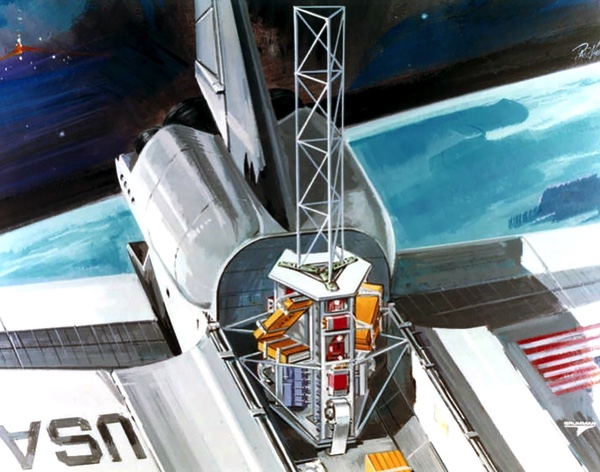 Grumman built a ground demonstration unit for the beam builder, but hoped for an eventual flight test. The beam builder would have been mounted vertically in the payload bay. (credit: Grumman Aerospace) |
The Grumman Beam Builder
As NASA was developing the shuttle in the early 1970s, the agency was also considering what role it would play in future space efforts. The shuttle’s large payload bay, its mission as a space truck hauling equipment and supplies to and from orbit, and the ability to have astronauts use the shuttle as a work platform, all spawned multiple mission and technology concepts.
The beam builder was one of these, and NASA and contractor engineers studied the possibility of operating the device while it was mounted in the shuttle payload bay, manufacturing structures that could then be connected together. The beam builder Grumman began work on was 4.26 by 3.35 by 2.74 meters (14 by 11 by 9 feet), weighed 9,979 kilograms (22,000 pounds), and could fit inside the payload bay. The flight version would be considerably lighter. It would use flight-qualified, higher-reliability parts compared to the off-the-shelf parts used in the ground demonstrator.
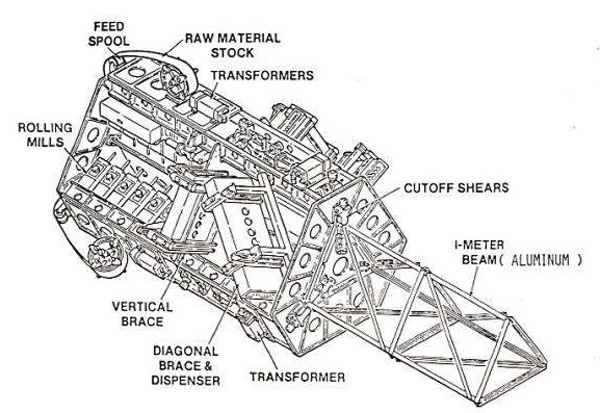 The Grumman Beam Builder evolved out of early-mid 1970s proposals for large space structures such as solar power satellites. Grumman built a ground demonstration unit that was delivered to NASA’s Marshall Space Flight Center in Alabama in 1978 and underwent testing there. (credit: Grumman Aerospace) |
Grumman’s ground demonstration unit manufactured aluminum “bays” that were 1.5 meters long and, during demonstration and testing, built beams of 1, 2, 4, 6, 7, 10, 11, and 12 bays. This proved the concept of automatic beam fabrication. Grumman had previously developed the bay design for a photovoltaic power system thermo/structural study. The design could be used for the solar array and the microwave antenna. It would be the building block for large structures. The concept was for the beam builder to be left in space with shuttle missions bringing up the materials to be used during manufacture.
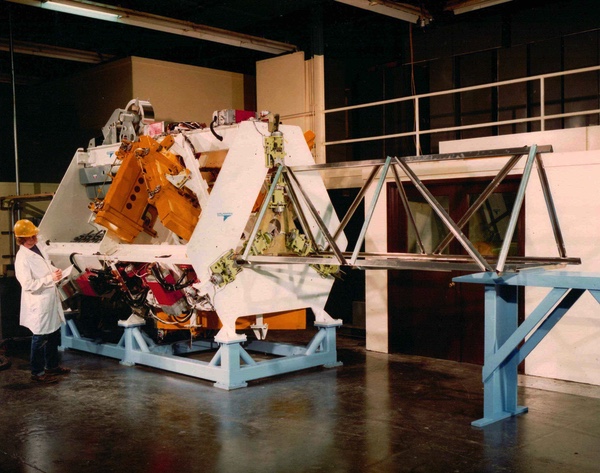 Grumman's initial design used rolled aluminum that would be spot welded to vertical and diagonal trusses. (credit: Grumman Aerospace) |
The beam building demonstration unit used off-the-shelf components to save time and money. A flight version would have to use all new space-qualified equipment. It would also have to be designed to operate in the vacuum of space and use far less power.
The beam builder had three spools of aluminum alloy, two mounted on each side and a third on top. The flat material was pre-cleaned to remove any oil or foreign matter and was 16.2 centimeters (6.375 inches) wide and 0.04 centimeters (0.016 inches) thick. It could be up to 300 meters (984 feet) long. The material moved through three sets of five rollers in the feed guide system which fed the material into the rolling mills system. It would then move on to the brace storage system, carriage system, spot welding system, and shear cut-off system. The brace storage system held the vertical and diagonal braces that would be fed into the machine.
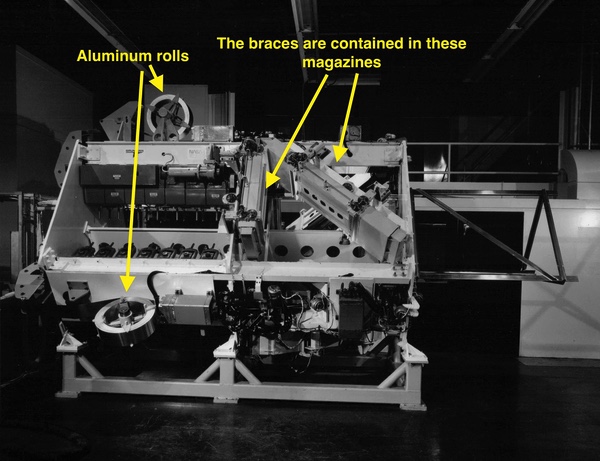 The Grumman Beam Builder ground demonstration unit used rolled aluminum as well as pre-made vertical and diagonal trusses. (credit: Grumman Aerospace) |
The spot-welding system had 72 electrode copper weld tips, six electrode copper weld blocks, six transformers, and a weld controller. Half of the copper weld tips spot welded the vertical braces and the other half spot welded the diagonal braces. The material had to be properly aligned as it moved through the machine to avoid flaws. After the fabrication cycle completed, the shear cut-off system would automatically cut off the triangular truss beam.
During testing at Marshall, several problems were encountered, which was not unusual or unexpected for a first of its kind technology demonstrator. While many of these were solved, one of the bigger problems was that “the beam builder spot welding system requires an excessive amount of energy for the fabrication of the triangular truss beams,” a NASA assessment concluded. Grumman therefore researched alternative fastening systems. These included self-piercing rivets, staples, grommets, stamp-lock, and other options. Some of these methods such as staples and self-piercing rivets had the disadvantage of producing debris, which could be a hazard to the machine, shuttle, and astronauts.
| One of the bigger problems was that “the beam builder spot welding system requires an excessive amount of energy for the fabrication of the triangular truss beams,” a NASA assessment concluded. |
In addition to the demonstration model, NASA also conducted tests inside the Neutral Buoyancy Simulator at Marshall, a large water tank that could be used to simulate weightlessness for astronauts and operated from 1968 to 1997 before it was replaced by a larger facility south of Houston, Texas. Truss structures that were apparently made by the demonstration unit were put in the tank along with a mockup in the overall shape of the beam builder. They were mounted to a mockup shuttle payload bay and tested with engineers wearing simulated spacesuits. The tests were focused on issues like payload bay clearance and how spacewalking astronauts could maneuver around the structures.
NASA decided on the pierce-and-fold system for further development because it required minimal energy, little or no maintenance, no additional material such as rivets, bolts, or staples, and no continuous adjustment. However, NASA had also evaluated an alternative technology using composite materials rather than aluminum. That will be discussed in part 2.
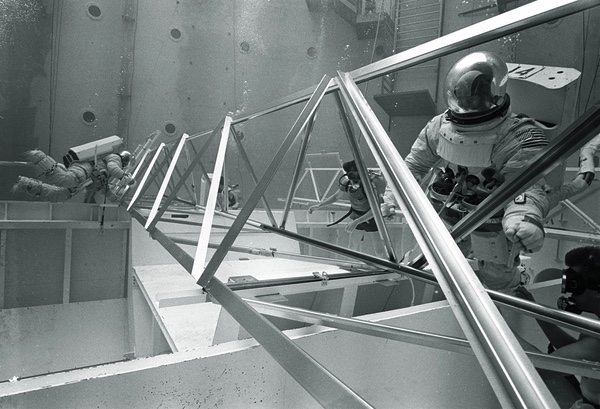 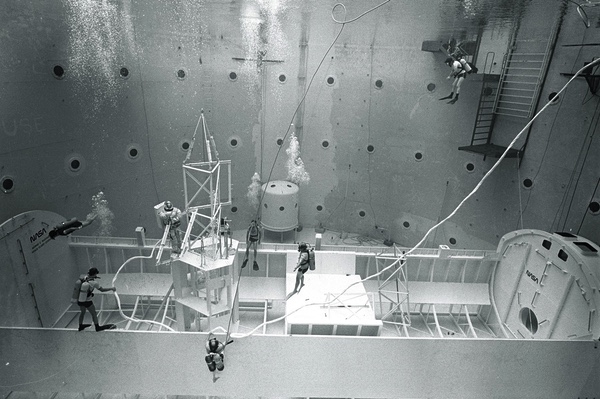 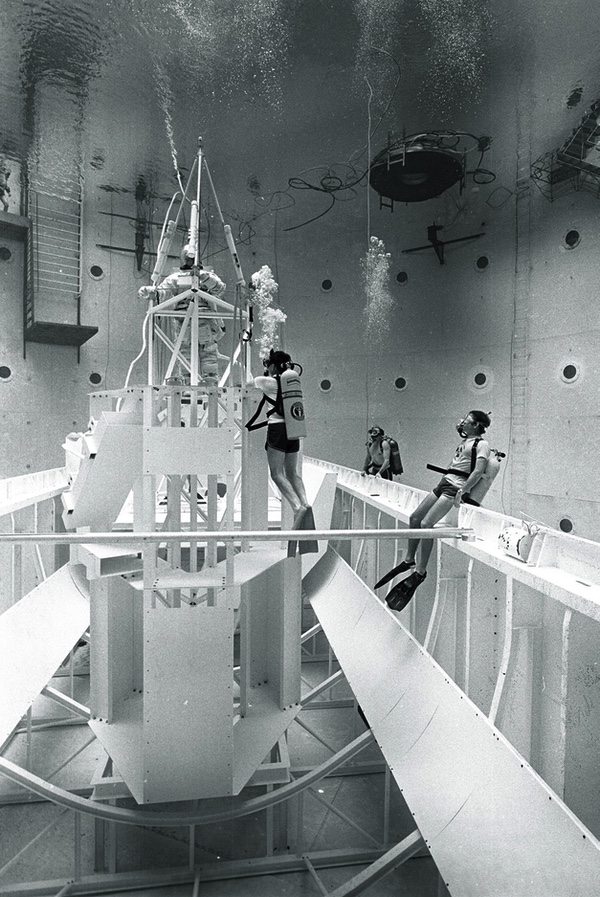 Trusses made in the ground demonstration unit were placed in Marshal's Neutral Buoyancy Lab for testing. (credit: Grumman Aerospace) |
Sources
E.O. Adams and C.N. Irvine, “MSFC Evaluation of the Space Fabrication Demonstration System (Beam Builder),” NASA Technical Memorandum TM-82440, George C. Marshall Space Flight Center, Marshall Space Flight Center, Alabama, September 1981.
Walter K. Muench, “Automated Beam Builder Update,” Space Solar Power Review, Vol. 1, pp. 299-316, 1980.
Space Construction Automated Fabrication Experiment Definition Study (SCAFEDS). Volume 1, Executive Summary, and Volume 2: Study results, General Dynamics, May, 1978.
Space Construction Automated Fabrication Experiment Definition Study (SCAFEDS). Part 2, Final Briefing, General Dynamics, February 3, 1978.
John G. Bodle, “Development of a Beam Builder for Automatic Fabrication of Large Composite Space Structures,” General Dynamics, NASA. Johnson Space Center The 13th Aerospace Mechanisms Symposium, January 1979.
Note: we are now moderating comments. There will be a delay in posting comments and no guarantee that all submitted comments will be posted.
